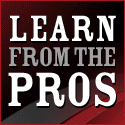By
Gary Steele
Poker has its own set of unique terms and jargon, and more are being added every week as its popularity continues to expand. There are names for particular starting hands, such as pocket rockets and big slick. There are terms describing poker scenarios, such as a bad beat. It would take a week to write them all, but I think the following list will give you a good idea of the terms you will hear used on a regular basis as you play.
- Backdoor Flush or Straight draw
- Three cards to a Flush or Straight on the Flop, needing two consecutive cards to complete.
- Bad Beat
- This term refers to when a player looses with a very good hand. For example, in Omaha when one player has a Full House and looses a big pot to a Four of a Kind, that player is said to have had a “Bad Beat.”
- Belly Buster
- An inside straight draw – When a player has 2, 3, 5, 6 where only a 4 on the next draw will give them a straight, the player has a “belly buster.”
- Bicycle Wheel
- Also known simply as the “Wheel” - The lowest possible “low” hand – Ace, 2, 3, 4, 5 – when vying for a low pot the fact that this makes a straight is not taken into consideration.
- Big Slick
- Having an Ace and a King in the hole (face down).
- Blank
- A card that does not improve your hand.
- Blind
- A forced bet (or bets) to player(s) to the left of the dealer to insure action on every hand.
- Board
- The face up community cards are said to be on the “board.”
- Boat
- Also known as a Full Boat - Another name for a Full House.
- Broadway
- An Ace-high Straight.
- Bubble
- In a tournament the position one place short of finishing in the money.
- Bullet
- Another name for an Ace – two Aces in the hole are called bullets.
- Button
- 1) A chip or token used to mark the position of the dealer when
the players are not dealing themselves.
2) The player currently seated at the seat were the token resides is on the “button.” - Buy-In
- The minimum amount of money required to join a table – usually dependant on the amount of the blinds or ante. Sitting down at a $1 No-Limit table usually requires a $50 “Buy-In.”


